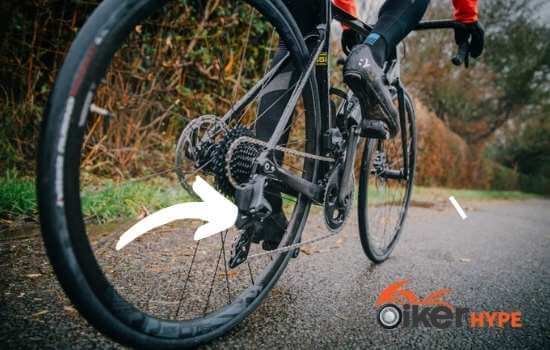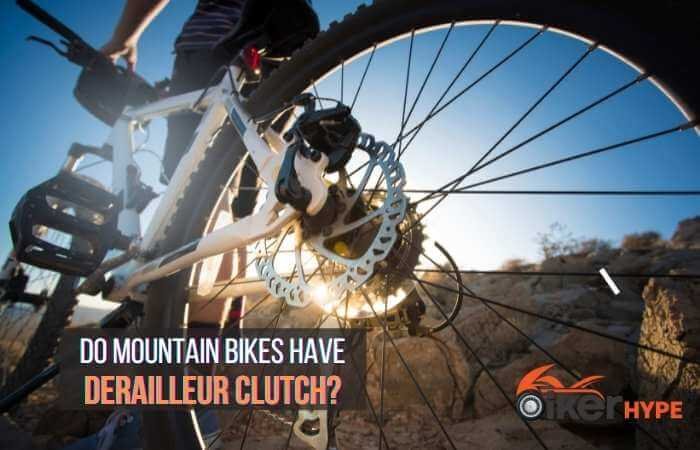While riding on your MTB through the rough rails, did you ever feel stiffer while shifting through the gears?
And what about shifting the gears with a derailleur clutch compared to the one without a clutch?
Also, don’t forget that a bicycle derailleur with the clutch systems allows the rider to adjust the level of stiffness at shifting.
This is just a very limiting example defining a bicycle clutch. Okay, now let’s put an end to your enthusiasm and know what a Bicycle Clutch is in the very first place?
A bicycle clutch is more or less like a controller of the gear system of your bike. The grip helps to retain the consistent tension of the chain over your bike’s derailleur to ensure the perfect output without any sound issues or damages.
It also protects the chain from slipping out of the chainrings and thus gives extra assurance to your rides.

Today’s article is all about the bicycle clutch and if you are interested in learning something new, keep an eye out till the last.
Related: How To Fix Bike Gears Shifter? (Click here to read full 7 step to fix gear shifter)
What Is A Derailleur?
Now you may think, from where this topic even came from in the first place. And, if you feel so, you don’t have enough idea about the bicycle derailleur clutch system. So you first need to interpret all about what a derailleur itself is.
With that being said, a derailleur in a bicycle is considered the variable ratio of gear systems that helps you ride your bike with a better, easier, and more advanced interface.
Previously, gear systems wear only seen on motor vehicles, including a car, motorcycle, and such categories. But, with time, people have even invented gear options and shifted the speed projections in manual vehicles like a bicycle.
That brings a derailleur under consideration when it is about the gearing system of a mountain bike or any other bicycle category. And a derailleur is mainly a mechanic that helps shift your bicycle’s speed from one level to another.
And, to do that, a derailleur help to shift the chain from an upper sprocket to lower or from a lower to upper. Derailleur also includes the chain system, sprockets of multiple or different sizes like smaller and more significant, along with the mechanism to shift the chain from one sprocket to another.
You will find many different models for the bicycle’s derailleur, but the exciting fact is that almost all of them work with the same basic principle. A bicycles derailleur is protected by the mountain bolt, which is adjusted to the derailleur hanger of the bicycle’s frame.
What Is A Bicycle Clutch?
Now, as we have covered the primary stages of the gearing system of a bicycle, we can jump into more detailing like a bicycle clutch and what they are!
A bicycle clutch or derailleur clutch is linked up and connected to the functionality of the bicycle’s derailleur. The main job of a grip is to assist the derailleur and help to remove functionalities of the same.
With that being said, a derailleur clutch mainly works with the chain system of your bike and prevents it from m drawing too much tension and stress to the derailleur. However, as crucial as a derailleur is, it is also sensitive to unconditional pressures and force, which can become the reason for its damages.
The derailleur clutch maintains and retains the tension on your derailleur, which you always want. If any up or down with this tension occurs or any imbalance occurs, the derailleur will bounce and move up and down, causing unnecessary chain noises with potential damage to the frame.
It also protects the chain from getting slipped out of the chainrings and obstructing your rides. The clutch is always located on the rear derailleur, which helps to shift the chains from one sprocket to another on the rear derailleurs of your bike.
While doing that, you may sometimes find your shifters hard and thought to press due to heavier tensions by the chain over your derailleur. With a derailleur clutch, you can easily remove the unnecessary stresses and thus get an easy and smooth shifting experience on the rear derailleurs.
It mainly occurs as the rear derailleur clutch dampens the pivot point situated at the top of your derailleur and thus restricting the derailleur arm to bounce and move, thus maintaining a consistent tension. In addition, it allows for the smooth transition of the chain throughout the derailleur.
Should You Ride Your Bike With The Derailleur Clutch Off Or On?
This one is the most interesting and asks a question that every bicycle enthusiast accord; the answer also varies depending on the level of enthusiasm and the bike’s person.
With that said, more is always better when it comes to bicycles, and it’s the efficiency of the gear systems. But that doesn’t mean you should jump into unnecessary adjustments and adding, which can cost you a fortune but come of no such great uses.
Coming towards the derailleur clutch of a bicycle, often it is a great thing that many riders prefer. It is mainly seen that the MTB riders are more into the bicycle clutch than the riders of any other category. Let’s not come into the fact that should you need a retailer clutch in your bike or not.
But, instead, we should be considering that if you already have a clutch on your bike, should you ride with the clasp on or off? The question at the same time also brought the fact that almost most of the bicycles with grip come to the option with a switch that allows you to on and off your clutch as per your need.
So when it is about using the switch of the derailleur clutch, to be exact, it likes going with the phase that more is better. That is to say, it is lovely to keep the clutch switch on as it will protect the chain from bouncing and moving along with providing a quieter ride.
But, if you are the one who is setting it to “off,” then it will be just like every other derailleur which doesn’t have one. And, according to the type of ride you want and place you are riding like a smooth road, it will be fantastic to go with your derailleur clutch off.
Do Mountain Bikes Have Derailleur Clutch?
Yes! Almost all high-end MTB manufacturer companies allow a retailer clutch to stay in its place right from purchasing for the first time. This is to say that they don’t even need to be adjusted as additional modifications for your bicycle’s rear derailleur.

But, those models of the MTB’S or Mountain Bikes which do not come with a clutch from the first should be adjusted with it as an additional accessory which will be worth your every penny.
The derailleur clutch is mainly invented for mountain bikes to add to their specific purpose. The primary goal is to ride on hill tracts, mountains, and roads that are not even smooth with lots of high and low steeps; they are treated with a particular thing called derailleur clutch.
The uneven road surface can interrupt the constant tension of the chain on the derailleur, which becomes the reason for the derailleur’s bouncing and moving.
So to protect such circumstances, a shift control over the chain and preventing it from slipping and causing stress to the derailleur is established through a clutch.
Read also: Why Do My Bike Brakes Squeak?
Do Road Bikes Have Derailleur Clutch?
A matter of interest is that Shimano has tried to bring the technology of a clutch on markets of road bikes with the derailleur of Shimano RX. Considering the pros that it provides, it may be a worthy investment but not a must-try option like the clutches in MTB.
Road bikes are made for riding on flat and smooth surfaces where no question of leaving additional forces on the derailleur by the chain is raised. So, here you would not generally need the mechanism to protect from scenarios that will not take place in the very first case.
Conclusion
A bicycle clutch is what we know as preventing the derailleur from the weight of the chain that can cause bouncing and damages to the same.
We have also learned many other things, such as a clutch keeping the chain taut and preventing it from slipping, and so on. All the necessary information regarding the bicycle clutch is availed in the article, beyond which you don’t require a single more word to get through!

Leave a Reply